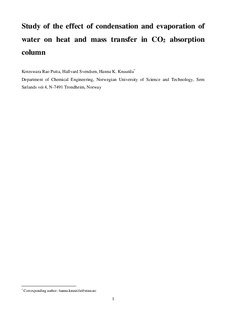| dc.contributor.author | Putta, Koteswara Rao | |
| dc.contributor.author | Svendsen, Hallvard Fjøsne | |
| dc.contributor.author | Knuutila, Hanna K | |
| dc.date.accessioned | 2017-08-07T12:06:41Z | |
| dc.date.available | 2017-08-07T12:06:41Z | |
| dc.date.created | 2017-07-19T14:45:34Z | |
| dc.date.issued | 2017 | |
| dc.identifier.citation | Chemical Engineering Science. 2017, 172 353-369. | nb_NO |
| dc.identifier.issn | 0009-2509 | |
| dc.identifier.uri | http://hdl.handle.net/11250/2450044 | |
| dc.description.abstract | A rate-based combined heat and mass transfer model developed based on penetration theory is used to study the effect of water evaporation and condensation on the CO2 absorption process using six different cases with real pilot-scale plants flue gas conditions. The effect of water evaporation and condensation on the concentrations, temperature profiles and reaction rates are studied in detail. The model predicted reasonable profiles as one would expect for water condensation and evaporation. The degree of liquid temperature rise depends mainly on the gas water saturation level and the temperature difference between the gas and liquid. Temperature profiles are flat in the liquid, whereas the transferring components create steep concentration gradients close to the interface making the interface concentrations change rapidly with position in absorber. This is in line with the thermal and mass diffusivities. Concentration build-up or depletion of species takes place in the liquid phase close to the gas-liquid interface up to 10 μm distance from the interface. For the case with absorber bottom pinch conditions, it was found that the CO2 flux sign changes and desorption occurred when taking the evaporation and condensation effects into account, whereas, without these effects, only absorption was predicted. For most of the cases, absorption rate of CO2 was not affected significantly even though concentration gradients and temperature changes were found. However, for the extreme case of warm unsaturated exhaust from an NG fired plant, case C1, and for the near pinch situation, case C6, significant changes to the CO2 absorption rates were found. | nb_NO |
| dc.language.iso | eng | nb_NO |
| dc.publisher | Elsevier | nb_NO |
| dc.title | Study of the effect of condensation and evaporation of water on heat and mass transfer in CO2 absorption column | nb_NO |
| dc.type | Journal article | nb_NO |
| dc.description.version | submittedVersion | nb_NO |
| dc.source.pagenumber | 353-369 | nb_NO |
| dc.source.volume | 172 | nb_NO |
| dc.source.journal | Chemical Engineering Science | nb_NO |
| dc.identifier.doi | https://doi.org/10.1016/j.ces.2017.06.037 | |
| dc.identifier.cristin | 1482614 | |
| dc.description.localcode | This is a submitted manuscript of an article published by Elsevier Ltd in Chemical Engineering Science, 23 June 2017. | nb_NO |
| cristin.unitcode | 194,66,30,0 | |
| cristin.unitname | Institutt for kjemisk prosessteknologi | |
| cristin.ispublished | true | |
| cristin.fulltext | preprint | |
| cristin.qualitycode | 2 | |
